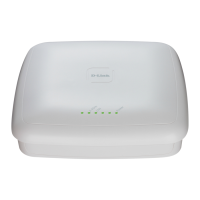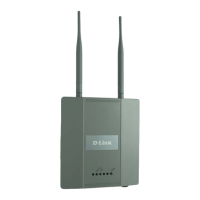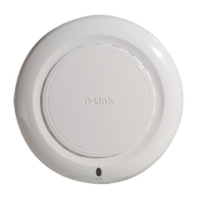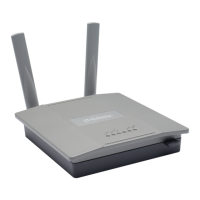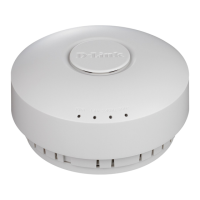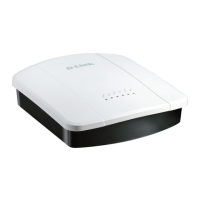D-Link Unified Access System Software User Manual
02/15/2011
Page 106 Document 34CS3000-SWUM104-D10
frequency and support use of channels 1 through 11. IEEE 802.11a mode operates in the 5 GHz frequency and supports a
larger set of non-consecutive channels (36,40,44, 48, 52, 56, 60, 64, 149, 153, 157, 161, 165).
Interference can occur when multiple access points within range of each other are broadcasting on the same or overlapping
channels. The impact of this interference on network performance can intensify during busy times when a large amount of
data and media traffic is competing for bandwidth. For the “b/g” radio band, the classical set of non-interfering channels is
1, 6, 11. Channels 1, 4, 8, 11 produce minimal overlap. A similar set of non-interfering channels is used for the “a” radio
band, which includes all channels for that mode since they are not overlapping.
Configuring Channel Plan and Power Settings
The D-Link Unified Switch software contains a channel plan algorithm that automatically determines which RF channels
each D-Link Access Point should use to minimize RF interference. When you enable the channel plan algorithm, the switch
periodically evaluates the operational channel on every AP it manages and changes the channel if the current channel is
noisy.
The automatic channel selection algorithm does not affect APs that meet any of the following conditions:
• The channel is statically assigned to the AP in the RADIUS or local AP database.
• The channel has been statically assigned to the AP from the AP Management > Advanced page.
• The AP uses a profile that has the Automatic Channel field disabled (Radio Configuration setting).
Additionally, radios configured to use Super A or Super G cannot use the channel plan algorithm.
The RF transmission power level affects how far an AP broadcasts its signal. If the power level is too low, wireless clients
will not detect the signal or experience poor WLAN performance. If the power level is too high, the RF signal might interfere
with other APs within range or broadcast the signal beyond the desired physical boundaries, which can create a security risk.
Automatic power uses a proprietary algorithm to automatically adjust the RF signal to broadcast far enough to reach wireless
clients, but not so far that it interferes with RF signals broadcast by other APs.
Note: The available channels depend on the country in which the APs operate. The channels described in this
section are valid for the United States.
Note: The regulation of radio frequencies and channel assignments varies from country to country. In countries
that do not support channels 1, 6, and 11 on the 802.11b/g radio, the channel plan algorithm is inactive. For the
802.11a radio, the algorithm is inactive in countries that require 802.11h radar detection, which includes European
countries and Japan.
Note: If the AP is not assigned a fixed channel or is not assigned a specific channel by the automatic channel
selection algorithm, the AP channel selection mode is set to best. This means that the AP selects the best channel
whenever the radio restarts or if the AP detects a radar signal.

